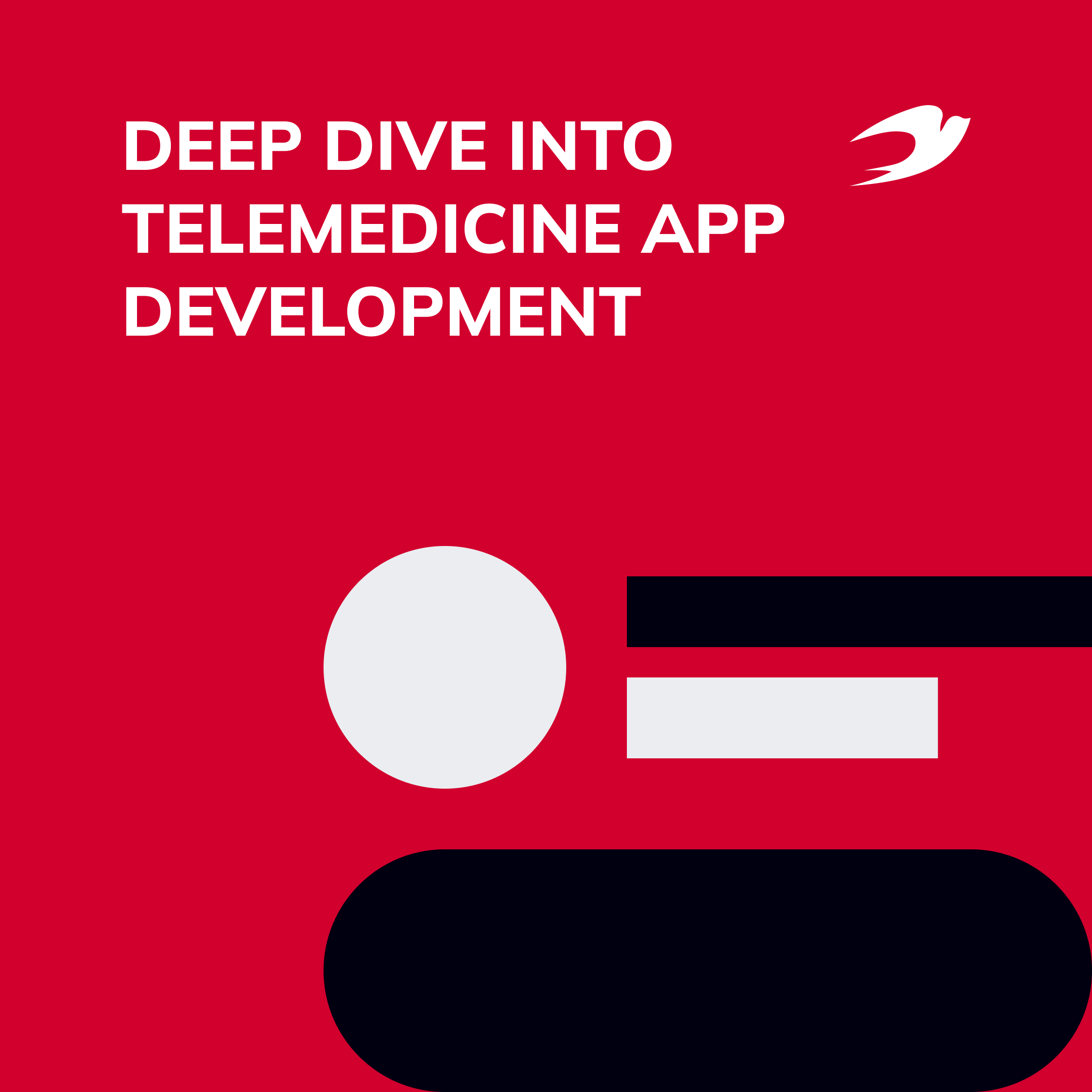Given recent events, the healthcare sector has been in the spotlight. As patients, we expect quality medical care services that meet new realities, and as healthcare providers want to use an efficient business model to help us achieve our business goals. And telemedicine has become the answer to both requests. This article covers the benefits of telemedicine solutions for doctors and patients, as well as the telemedicine app development process. Get ready, we’re diving into this exciting topic right now!
Table of contents:
- Telemedicine market overview
- Types of telemedicine apps
- Features for patients
- Features for doctors
- Telemedicine app development steps
- How much does it cost to develop a telemedicine app?
- How we can help
Telemedicine market overview
Designed to facilitate patient access to medical care, telemedicine uses modern technology to monitor and treat patients remotely. And this approach is becoming more widespread in the world. According to Fortune Business Insights, the global telemedicine market size was $41.63 billion in 2019, and in line with a new report from Grand View Research, that figure will reach $298.9 billion by 2028. Also, Statista predicts the global telemedicine market to reach $460 billion by 2030.
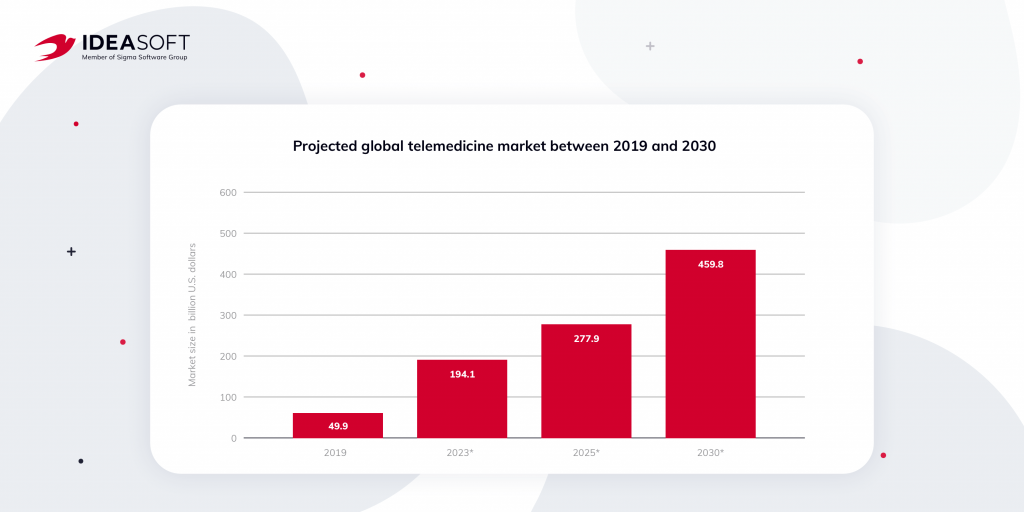
This rapid market growth is largely related to the outbreak of the COVID-19 pandemic. Overcrowded hospitals, a shortage of medical personnel, and the need to maintain social distance have all made telemedicine the most reasonable solution in the current environment. Telemedicine brings down the burden on physicians, as well as reduces the cost of providing medical services to patients. So it is not surprising that government agencies are paying more attention to the implementation of digital healthcare technologies, contributing to the rate of market growth. For example, in March 2020, the US Federal Communications Commission developed programs to assist healthcare providers in deploying telemedicine technologies.
The widespread adoption of 5G is also driving the development of telemedicine. The improved internet speed will allow doctors and patients to communicate remotely without worrying about network outages, blackouts, or delays. Moreover, 5G also enables seamless connectivity by integrating medical devices into a single network. This gives patients access to a wider range of professionals.
Types of telemedicine apps
According to statistics from McKinsey&Company, the growth of users of telemedicine applications has increased from 50 to 175 times compared to the period before COVID-19. In response to demand, more and more telemedicine platforms and apps are emerging every day. Therefore, before moving on to the process of telemedicine app development, we should consider their types and functions.
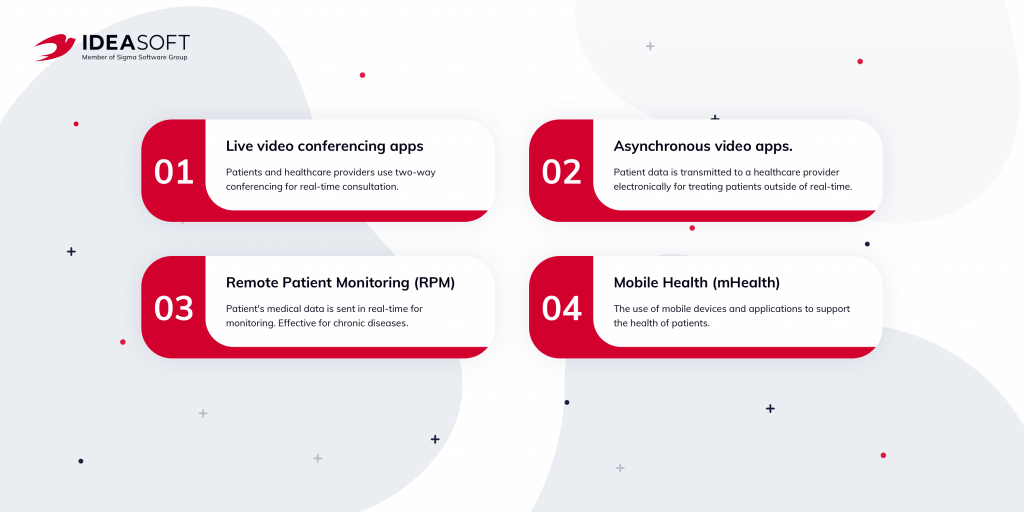
So, you can build one of the following telemedicine applications:
- Live video conferencing apps. These are applications allowing real-time interaction between doctor and patient. In many ways, this is similar to regular live doctor consultation. Live video conferencing apps allow patients to quickly get medical advice wherever they are. The use of this technology helps to save time and costs of treatment. This is the most popular type of telemedicine application.
- Asynchronous video (Store-and-Forward) apps. Unlike live video conferencing apps, these types of telemedicine apps do not provide real-time interaction. Asynchronous video apps are used to transmit a recorded medical history via an electronic communication system to a practitioner who uses it to evaluate a case or provide a service out of real-time. In this way, a healthcare provider can simplify its workflow and provide a patient with more timely and better treatment without referring the patient to another specialist.
For example, in ophthalmology, eye screening for diabetic retinopathy can be digitally recorded using retinal cameras and then sent to a specialist for review.
- Remote Patient Monitoring (RPM). Some chronic diseases like heart disease, stroke, epilepsy require constant monitoring. RPM solutions help to securely store all patient data in a single place and quickly transfer it to a healthcare provider for evaluation. Thus, a medical specialist will be able to quickly determine changes in the patient’s health and provide the necessary treatment. Experts argue that the use of such applications helps to reduce the number of emergency department visits, hospital admissions, and readmission rates.
- Mobile Health (mHealth). These apps allow you to monitor your health using mobile technology. For example, health tracking apps like fitness trackers, etc. mHealth is also used to screen patients, help with treatment, track outbreaks and manage chronic diseases. The use of mHealth is helping to make medicine more accessible, as well as improve the quality of healthcare services.
Each of these types of apps has its own list of features. We’ll take a look at the most popular telemedicine app features that you are likely to want to include in your product. It is worth noting that a telemedicine application usually consists of two sides – functionality for a patient and functionality for a doctor.
Features for patients
So any creator of a telemedicine product wonders what are the essential features to develop a telemedicine app. Don’t forget that a healthcare app should be convenient and useful for both patients and physicians. Therefore, before you start telemedicine app development, you should carefully study the needs of both parties, as well as carry out competitor analysis. This will help you create a functional application that meets the needs of your target audience.
Let’s start with the patient features. As patients, users of your app should be able to select a medical provider and make an appointment. Therefore, you need to take care of the following functionality of the telemedicine application.

Sign up
Sign up feature for a telemedicine app is not as easy as it seems. Since the app will contain a lot of sensitive data, you must ensure that this information is stored and transmitted completely securely, and no third parties will be able to access other people’s accounts. Usually, a user is presented with several registration options, using email or third-party tools like Facebook Login or Google Sign In. Also, don’t forget about two-factor authentication as a basic security feature for a mobile application.
Personal profile
It is much more convenient for patients to store all information about treatment and consultations with doctors in their personal accounts. In addition, a personal profile makes it possible to store and open access to electronic health records (EHR) for medical professionals. So a doctor will be able to monitor the current condition of patients and look through their previous treatment history in order to prescribe the most effective treatment. However, you should keep in mind that if you plan to use such electronic medical records, you must fully comply with the regulations of the region you intend to work with. For example, in the USA you need to comply with HIPAA.
Search and filters
Finding a medical professional can be a real challenge. Make sure that your users can quickly and easily find the right doctor using the built-in filters. For example, enable patients to filter physicians by specialization, proximity, doctor’s rate, rating, and more.
Video conferencing
Video communication is one of the key features of telemedicine applications, as it allows doctors to remotely examine patients and prescribe the correct treatment. Therefore, you need to provide high-quality video and clear audio. You can also allow patients to record consultations so they can get back and remember the most important points. Also, do not forget that application users may have different internet connections, so your app should automatically adjust the video quality.
Text chat
Along with video conferencing, you shouldn’t forget about text chat. Some questions can be resolved in text messages, saving time for both parties. Also, chat should provide the ability to exchange media files. Needless to say, sending and receiving such sensitive data requires an increased level of security. Make sure to use cryptographic algorithms to make the data reliably protected and immutable.

Book appointment
Convenient appointment scheduling is a must-have for any telemedicine application. Give patients the opportunity to see a doctor’s available time slots and send meeting requests. In addition, a patient should be able to cancel or reschedule the appointment. Also, as soon as the doctor confirms the appointment, the patient must be notified. We advise you to integrate with Google Calendar to make the process as simple and efficient as possible for both parties.
Payment
When implementing a payment feature in your application, you can choose between a custom payment service or a third-party system like PayPal. Remember that the speed and security of transactions matter. When choosing a third-party system, make sure that it’s reliable and it has reasonable fees. If you are looking to create your own payment system, P2P payments can become a great benefit for your users. Also, telemedicine services can often be covered by insurance, so we advise you to consider the option of adding an insurance provider.
Notifications
Email and push notifications are useful for both users and you. First, notifications can increase user engagement and improve user experience. For example, reminders of an appointment or a received chat message. Secondly, by using notifications, you can keep users informed of the latest updates to your application. However, remember that notifications shouldn’t annoy users in any way. So it is better to give them the opportunity to independently choose which alerts they want to receive.
Review and ratings
When implementing features for a telemedicine app, don’t skip the review and rating system. Allow patients to evaluate the work of doctors, which will simplify the choice of a specialist for new users. Also, this way physicians themselves will be able to receive feedback on their work and find ways to improve.
Features for doctors
Now let’s talk about what features should be implemented in your application to make it convenient for doctors to work with it.
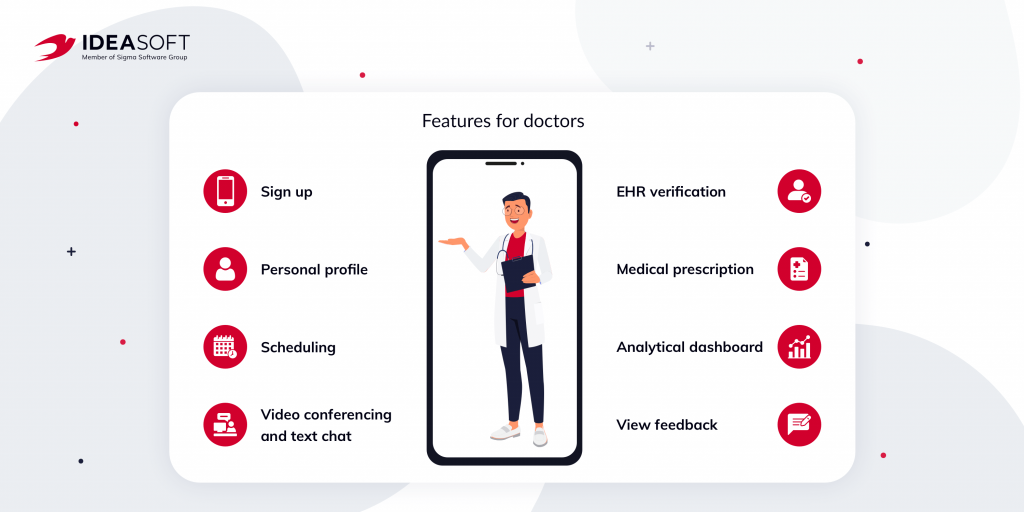
Sign up and personal profile
When registering, doctors may need to provide more information about themselves than patients. The more a physician can tell about himself, the easier it will be for patients to be convinced of the reliability of this specialist. The doctor’s profile should contain information about his education, specialization, experience, certificates, and so on. Preparing all the required fields for filling out will greatly facilitate and speed up the registration process.
Scheduling
Doctors can have a huge workload, and one of the main goals of telemedicine apps is to provide healthcare professionals with an effective task management tool. Therefore, create a convenient calendar for doctors where they can organize the accurate workflow and avoid mistakes in the work schedule. Also, physicians should be able to place appointments in patients’ schedules, reject or approve patient-initiated appointments, and so on.
Video conferencing and text chat
Telemedicine applications involve two-way communication. Therefore, make sure that on the doctor’s side video conference and text messaging features are also implemented with high quality.
EHR verification
We have already mentioned that in order to provide quality diagnostics and treatment, a doctor must have access to a patient’s medical history, the so-called electronic health record (EHR). The physician must be able to request access to this data from the patient. Make sure no unapproved user can download the EHRs. Safe storage of patient data is one of the most important tasks that a telemedicine app development team should set itself.
Medical prescription
This is a great feature that benefits both doctors and users. By implementing digital posting of medical prescriptions, you ensure that this important information doesn’t get lost in correspondence. And patients will be able to use this prescription to get the medicine at the pharmacy.
Analytical dashboard
This is something physicians will really thank you for. Combining data in one place allows doctors to effectively analyze their activities, see changes in the statuses of appointments and the progress of patient treatment. By providing a well-visualized and well-thought-out dashboard, you will significantly improve the visibility of doctors’ workload.
View feedback
Finally, it is not only patients who need to be able to provide reviews. Allow doctors to receive and respond to feedback. Healthcare professionals need to know how they can get better and at the same time be able to protect their reputation if they are confronted with a dishonest patient.
Telemedicine app development steps
When looking for an answer to the question of how to build a telemedicine application, you cannot ignore the development process. An experienced development team will always help and guide you, but being aware of how apps are created will definitely not hurt you and even help you realize what to prepare for. Let’s take a look at the key steps of telemedicine app development.
Discovery phase
The discovery phase is a crucial step in the development of a telemedicine application. In general, this is the stage of gathering information about a project and creating a work plan. Sounds simple? In fact, this is one of the most difficult stages, because success depends on how clearly you set goals and write down the requirements.
During the discovery phase, business analysts will help you determine the goals of the project, target audience, list of features for your app, list of integrations, etc. This will help define the scope of work and possible risks of the project. Developing software for the healthcare industry is a challenging task as it must meet the highest security standards and comply with regulations. The discovery phase will help you not miss anything and have a clear plan for creating and bringing your product to market.
Throughout the discovery phase, you can expect to get deliverables such as a Solution vision document, PBIs (Product Backlog Items)/Lists of functional and non-functional requirements, architecture design, UX wireframe design, prototype, release plan, and cost estimate. We do not recommend skipping this step, as the discovery phase will help you optimize your budget and reduce project risks.
Design
It is no secret that many projects have failed due to poor design. And it’s not only about the appearance of the software, but about the logic and convenience of the user interface. The main task of UX/UI designers is to create simple navigation that allows users to solve their problems. A patient installs your application to have an effective tool for interacting with healthcare providers. And if he spends a lot of time figuring out how to navigate your app, he will probably just delete it and download another one.
UX/UI designers will be able to create the best user interface logic based on your project and target audience data. If you want to enter the market with a quality product, take care of its design in advance. Many software development companies have in-house design departments. For example, at IdeaSoft, we have a staff of experienced UX/UI specialists who collaborate with other departments to create a design that best suits the goals of the project and is easy for further deployment.
Development
Once you’ve decided on the design, it’s time to bring it to life. We will not dwell on all the technical nuances of the question of how to make a medical app, but we will tell you about the main points. Application development always takes place in accordance with the documented requirements and the selected technology stack. The technology stack for telemedicine apps includes programming languages, frameworks, databases, and third-party APIs like messaging, videoconferencing tools, and others.
The development time depends on the complexity of the project, which is formed based on the number of features and integrations, as well as the type of application. For example, if you decide to build native iOS and Android apps, it will probably take longer than building a single cross-platform app. Read how to choose between native and cross-platform development here.

Testing and maintenance
It probably won’t be a surprise to you if we say that timely application testing is the key to its successful operation. By involving testers in the telemedicine app development process, you can make sure not only that it works as intended, but also that it is free of vulnerabilities. A data breach or app hacking will ruin your reputation forever. Therefore, it is so important to confirm that your telemedicine app is secure and reliable. This is what testing can achieve.
Different apps may involve different types of testing. The main ones are functional, performance, usability, compatibility, and security testing. Don’t neglect testing as bugs and vulnerabilities can cost you more in the future.
Once you and your development team are confident that the application works flawlessly, it’s time to deploy it on the servers and submit it to app stores if you planned to do so. That’s it! However, you should keep in mind that the software is software and it needs updating and support. Therefore, decide which specialists will do this for you and keep in touch with your development team in order to quickly make changes to the product if necessary.
How much does it cost to develop a telemedicine app?
Now when you know how to develop a telehealth app, you probably wonder how much does it cost to develop such an app. We don’t want to confuse you by naming the numbers because, in fact, the price varies from project to project and depends on many factors. If you want to get an estimate of your project, just contact us and we will study your specific requirements.
So what affects the cost of developing an application?
- The number of features and their complexity
- Supported browsers, devices, and operating systems
- Number and complexity of integrations
- Custom designs
- Location and structure of the development team
It is also worth considering the costs of payment integrations, App Store and Google Play fees, servers and backend support, and the like. One of the most significant factors affecting development costs is the structure and location of your development team. For example, according to YouTeam, the average development hourly rate in North America is $55, while in Eastern Europe it is $37. The difference is significant, isn’t it? So, choosing the best destination for outsourcing, consider the best option regarding price and quality.
How we can help
Telemedicine app development is a complex process, so you better find a reliable software development partner. You need not only experienced developers who know how to best implement this or that feature, but also specialists who know the specifics of creating software products for the healthcare sector.
IdeaSoft has been developing advanced software solutions for Fintech, Telecom, B2B, B2G, Smart City, DLT & Blockchain, Logistics, and Healthcare industries for over 5 years. Our in-house development team consists of skilled developers, designers, business analysts, QA, and other specialists who are able to solve the full list of tasks related to telemedicine app development.
In IdeaSoft’s portfolio, you will find more than 250 successfully completed projects, including solutions for the healthcare sector. In particular, we have created a feature-rich telehealth platform that allows not only communication between patients and doctors but also simplifies the management of internal events for healthcare providers, an efficient organization of workflow and data storage operations, streamlining business processes. The platform consists of two separate applications, one for doctors and one for patients.
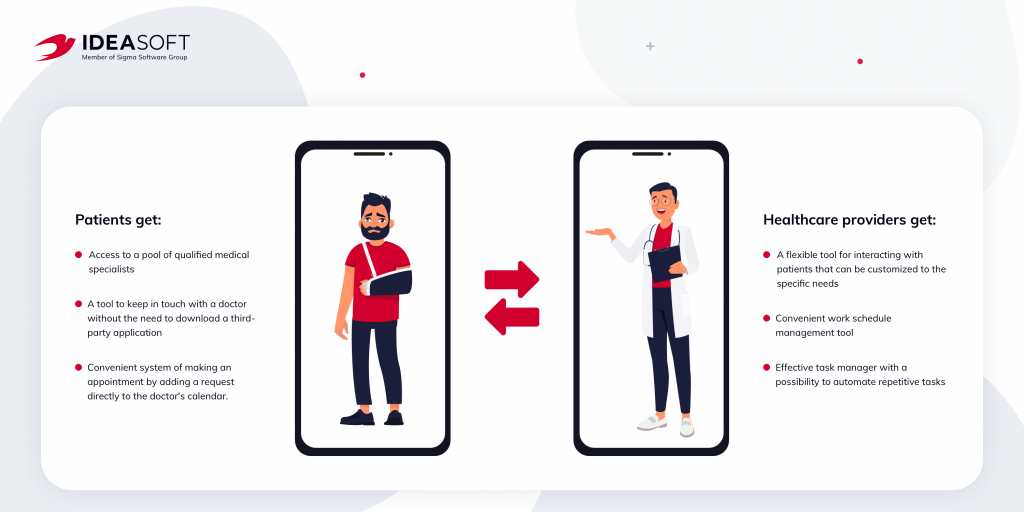
Also, doctors and patients can exchange media via private chats. All data is reliably protected by cryptographic algorithms.
If you want to create a telemedicine app like this, feel free to contact us. IdeaSoft specialists will carefully study your requirements and offer you a solution that best meets your business needs.
So, now you know how to develop a telemedicine app and how we can help you. Thank you for reading this post. We will be happy to see you among the blog subscribers.

